Vesta’s bright and easy to find in late summer skies. It’s also just as easy to acquire a piece of it — without a multi-billion dollar space mission.
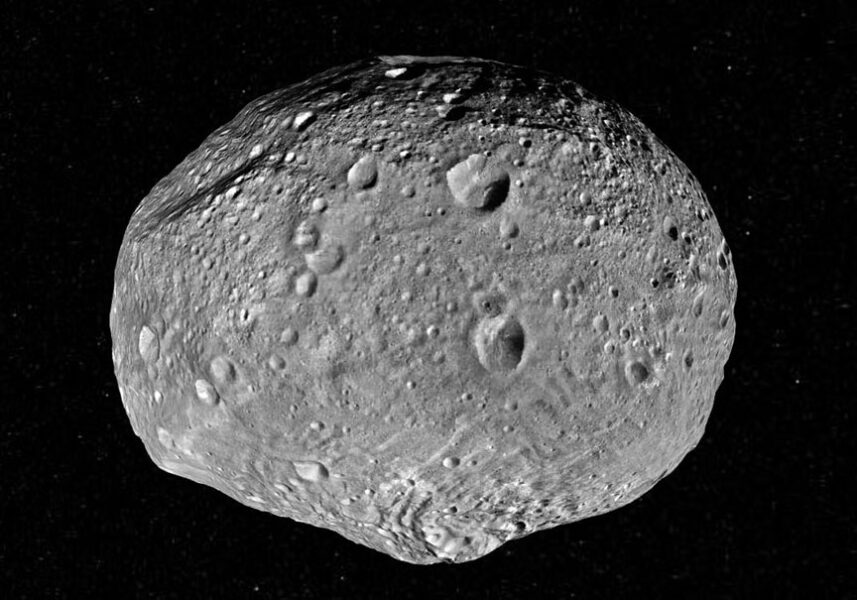
NASA/JPL-Caltech/UCLA/MPS/DLR/IDA
If you've never spotted an asteroid without optical aid, Vesta can help realize that dream. The solar system's brightest minor planet comes to opposition on August 22nd in southwestern Aquarius about 11° southeast of Saturn at an attainable magnitude 5.8. That's a smidgen brighter than the traditional naked-eye limit of 6.0, making it possible to spot the object sans optics from a dark sky. Just remember that 360° of darkness isn't a requirement. I have blots of light pollution to my south, southwest, and northwest, but the southeastern sky is sufficiently inky to make the attempt.
Vesta made its closest approach to Earth on August 17th at 191.8 million kilometers (119.2 million miles) and won't get any closer until May 2025. Now through September, it retrogrades from Aquarius into Capricornus, its path bounded on the east by the Helix Nebula (NGC 7293), a large, captivating planetary nebula, and on the west by the bright globular cluster M30. After lured by Vesta to this part of the sky, consider a telescopic stop at both before you leave.
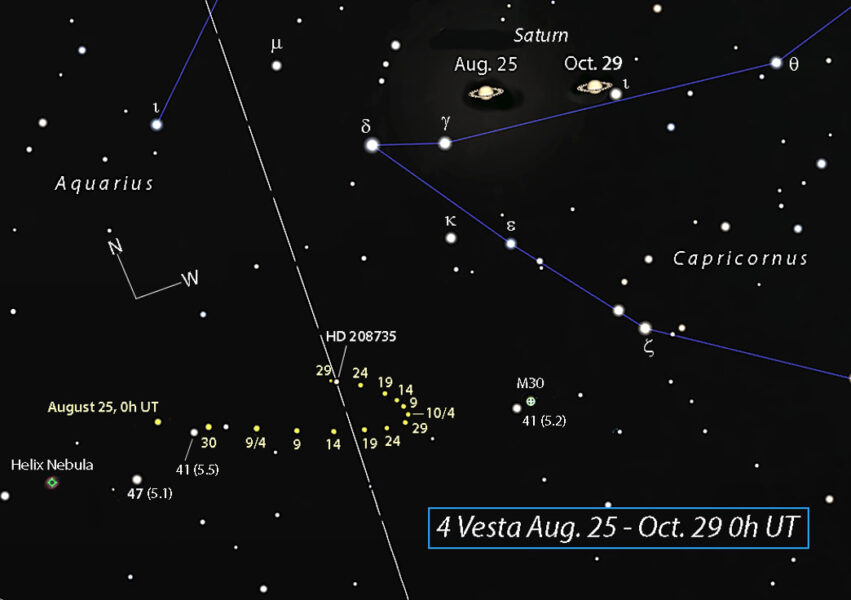
Stellarium
My favorite way to spot an object at the limit of vision is to connect it into a pattern with brighter naked-eye stars. For example, I might create a box with Vesta as one of the corners. Instead of staring directly at the asteroid I'll see it as part of the figure.
In truth, the asteroid may appear a few tenths of a magnitude fainter than its listed brightness due to atmospheric extinction. If you can't see Vesta without optical aid, no worries. A plain vanilla pair of binoculars will easily show it. After a few nightly visits, you'll know exactly where to point and also be able to watch this "star" that won't stay put track slowly westward. Through a telescope it appears pale yellow and 0.56″ across, or half the apparent size of Jupiter's moon Europa. That's probably too small to resolve visually, but who knows? The angular resolution of a 12-inch telescope in yellow-green light (555 nanometers) under ideal conditions using high magnification is 0.46″. Any takers?
Of Hearth and Home
German astronomer Heinrich Olbers discovered 4 Vesta in March 1807 just five years after finding the second asteroid, Pallas, in 1802. Its name recalls a kindness. Having already had the pleasure of naming Pallas, he gave the honor instead to Carl Friedrich Gauss, the German mathematician whose determination of Ceres' orbit led astronomers to its confirmation. Gauss christened it Vesta after the Roman goddess of home and hearth.
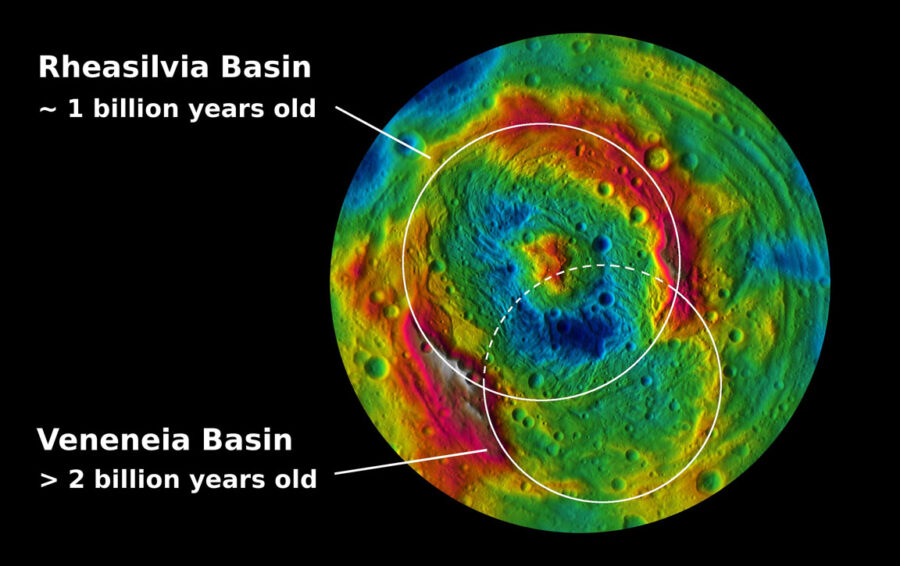
NASA, JPL-Caltech, UCLA, MPS, DLR, IDA, PSI
Not only is Vesta the brightest asteroid, but it's the second largest in the main belt and one of the few to be studied in situ. NASA's Dawn spacecraft parked itself in orbit around the spud-shaped body from July 2011 and devoted more than a year to its study. Among many discoveries, we learned that Vesta was a differentiated planetary body like the Earth — a protoplanet — with an iron-nickel core and a rocky mantle. It may also have been sufficiently spherical to be classified as a dwarf planet before two major impacts devastated the south polar region. Following the double catastrophe, the orb was no longer plastic enough to mold itself into a ball.
Two Lucky Strikes
The impacts left two enormous overlapping craters: the younger 500-kilometer-wide Rheasilvia centered near the south pole and its near-twin Veneneia (400 km). In the aftermath, rock and debris launched into space became the Vesta family of asteroids, pieces of which have landed on Earth and from there into the display cases of museums and meteorite collectors. Using its visible and infrared mapping spectrometer, Dawn sealed the connection between in-situ Vestan rocks and those found on Earth.

Bob King, Jon Taylor (CC BY-SA 2.0) and Steve Jurvetson (CC BY-SA 2.0)
Vestan meteorites are all achondrites, which means they've undergone extensive heating and melting, exactly what you'd expect on a protoplanet. There are three basic types: eucrites, formed of solidified surface lavas; diogenites, which crystallized deep within the asteroid's mantle; and Howardites, composed of eucrites and diogenites that were shattered, mixed, and cemented into new rock by meteorite impacts. Together they're known as the HED (Howardite-eucrite-diogenite) clan. More than 2,600 have been classified to date, with most originating from Vesta.
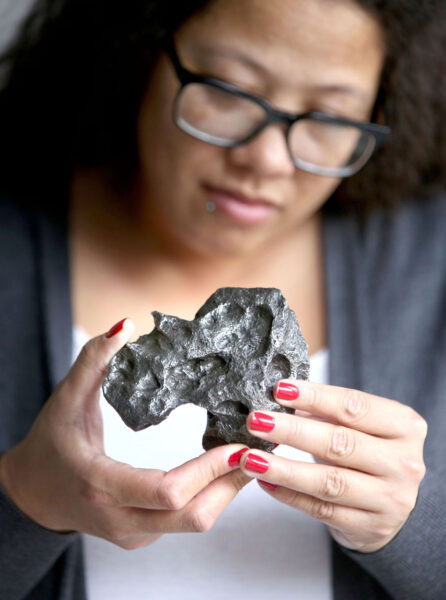
Bob King
Meteorites let us to touch something not-of-Earth and extraordinarily ancient. I like to place a space rock in someone's hands and tell them that it came special delivery straight from the asteroid belt. Then I walk them back 4.5 billion years to its origin as rubble in the condensing solar nebula. After palming the rock, they'll often bring it up to their nose for a sniff test. Iron meteorites often have a slightly sour aroma; stony meteorites are more neutral unless you scrape it against some sandpaper, when you can sometimes smell sulfur.
Hunting for Vesta on Earth
We live in a wonderful time when meteorites of all types are available for sale from many venues including online auction sites such as eBay, stores maintained by meteorite enthusiasts, and social media groups run by avid collectors who offer specimens for sale or trade. This makes the miraculous possible — owning a piece of an asteroid otherwise only visible in a telescope. And for just a few dollars, no less.
A number of legitimate sellers offer meteorites for auction (or for sale) on eBay. Eucrites typically run about $4–10 per gram; diogenites anywhere from $5–25 per gram, and Howardites from $10–50 a gram. Forget about SpaceX and Blue Origin — a 3–4 gram eucrite from Vesta delivered to your door will set you back about $15. As with anything, you can get in deep and spend a lot of money, but there's no need to.
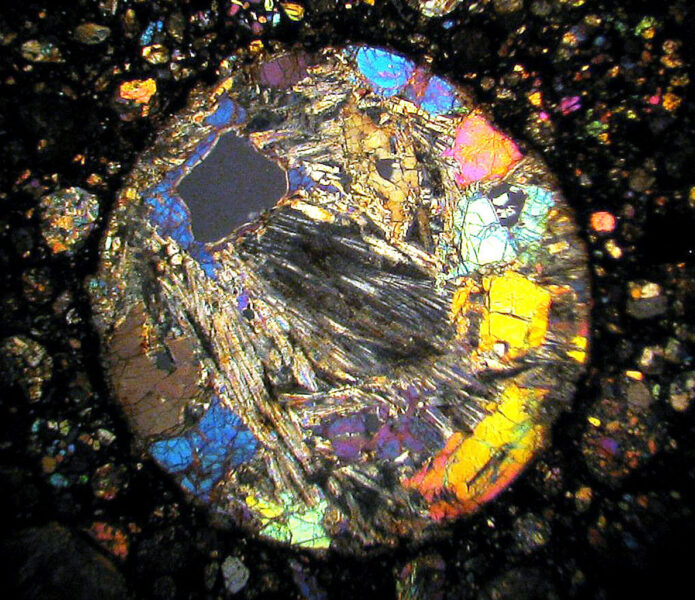
Bob King
Starting a Meteorite Collection
If you do acquire a meteorite you may find you'd like to collect a representative of each major type, say an iron-nickel meteorite or a stony chondrite. Chondrites are more "primitive" material, less altered by heating and impact than the HED bunch. They often contain chondrules, tiny spheres of silicate rock believed to have formed during a flash-heating event 4.56 billion years ago that transformed dust in the solar nebula into molten, free-floating droplets. Chondrules likely stuck together to begin the long road to building the first asteroids and from there, the planets.
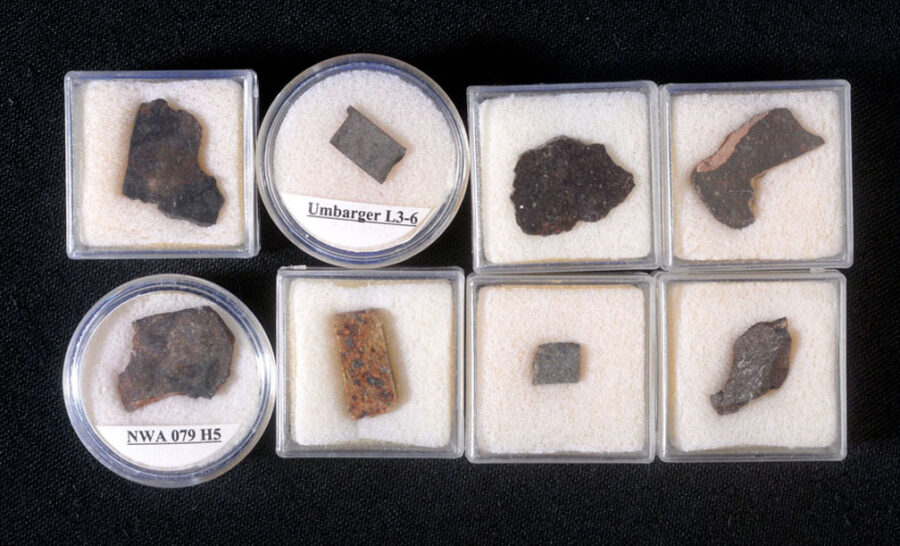
Bob King
For those on a budget who'd like a simple starter collection, I'd recommend the following:
- Vesta sample — your best bargain would be a small slice of a eucrite such as NWA 14682 or NWA 8555. This trusted eBay seller is currently offering box sets of all three Vestan meteorite types.
- Iron meteorite — a slice or small individual at around $1 per gram.
Good starter choices: Campo del Cielo (Argentina) or Agoudal (Morocco). Canyon Diablo from Arizona's Meteor Crater costs around $2–5 per gram. Be aware that irons can be prone to rusting, so store them in a dry place with a desiccant. - Chondrite (stony meteorite) — a slice or small individual at around $1–3 per gram. Unclassified chondrites, which are meteorites but have not been officially classified, can often be had for much less.
Good starter choices: a slice of NWA 869 (Sahara Desert), Chelyabinsk (from the February 2013 Russian bolide, ~$15 per gram) and Hammadah al Hamra 346 (Libya, possibly fell in 2019, $2–4 per gram.) - Pallasite — a mantle meteorite composed of iron-nickel metal and beautiful green (or orange or yellow) olivine crystals. Many collectors consider them the prettiest of all space stones.
Good starter choice: Sericho (Kenya) at $1–4 per gram. Beware! Do not buy any Sericho coated in epoxy resin. Resin seals in moisture which will gradually rust the meteorite and split apart the resin. Etsy and eBay offer hundreds of them. Steer clear and only consider a resin-free slice.
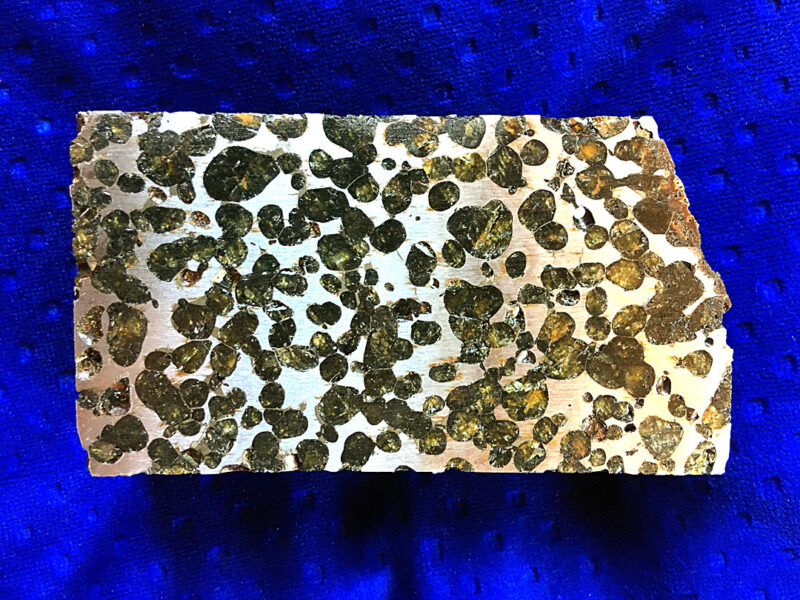
Bob King
When buying anything check the source. Multiple positive feedbacks can help. Some sellers are members of the International Meteorite Collectors Association (myself included!) or the Global Meteorite Association (GMA). You can buy from these folks with confidence. Members of the Facebook group Meteorites, Tektites, Impactites & Ephemera possess encyclopedic knowledge about meteorites and related impactites and frequently post sales on the site. They're also happy to answer questions you might have.
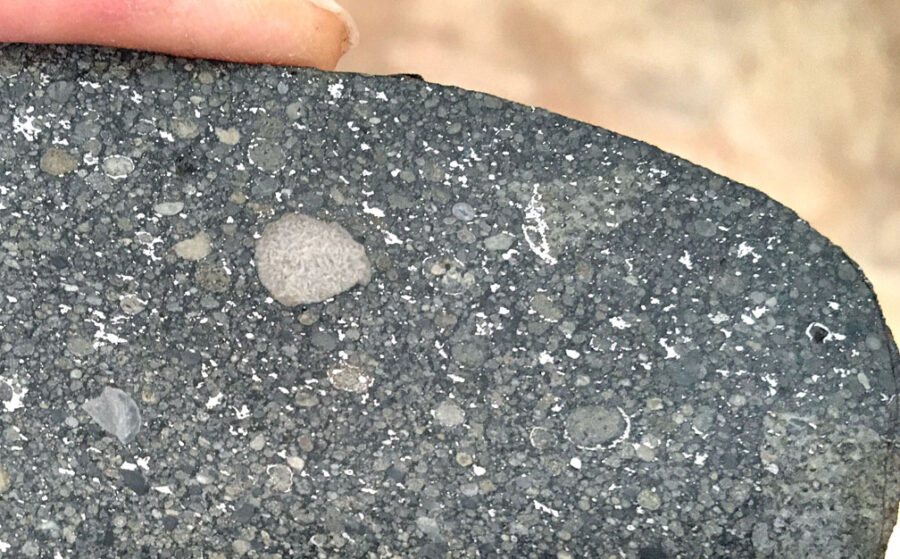
Bob King
Here are some additional 100% trusted sites and sellers. The list is necessarily incomplete. Sorry if I missed you!
- Polandmet Meteorites
- Meteorites for Sale
- Meteorite Market
- SV-Meteorites
- Allmeteorit.com
- Meteor-center
- eBay sellers: azmeteorites, fujmon, mirko66, mr-meteorite, lex-met, craizlime_0, zzlimenmnm, ari.machiz.meteorites, wwmeteorites-25, meteoritehunting, matt992011, mhmeteorites, cometshopnew, eegooblago_meteorites, lukaszsmula, msg-meteorites, amunre, spaceballs79
 6
6









Comments
Anthony Barreiro
August 25, 2022 at 5:34 pm
Thanks Bob. I've always imagined that meteorites were very expensive. It's good to know that a small representative collection wouldn't cost an arm and a leg.
During her current apparition Vesta is well south of the ecliptic, at opposition she was at 20 degrees south declination -- five degrees farther south than Saturn. I was able see Vesta in the morning sky from early May until early July, then a long spell of cloudy skies and inconvenient late night transits, but I lucked out on opposition night and caught a glimpse through binoculars in the late evening Monday night. Vesta is my favorite asteroid, simply because she is the brightest and easiest to see.
You must be logged in to post a comment.
Bob KingPost Author
August 29, 2022 at 11:05 am
Thanks, Anthony. I like bright and easy sometimes, too. I often bring a meteorite or three to my presentations, and people so enjoy touching something from space. A space rock adds a solid dimension to much that is "nebulous" in astronomy 🙂
You must be logged in to post a comment.
Rod
August 27, 2022 at 11:54 pm
I was able to track down and observe 4 Vesta, star hopped 66, 68, 47, and the double star 41 Aquarii to its location. Full report posted here, https://skyandtelescope.org/astronomy-news/observing-news/this-weeks-sky-at-a-glance-aug-26-sept-3/#comment-385246
I viewed Saturn and Jupiter too using my 90-mm refractor telescope at 71x.
You must be logged in to post a comment.
Bob KingPost Author
August 29, 2022 at 11:03 am
Hi Rod,
Yes, the whole enchelada — Jupiter, Saturn, M30 and the Helix!
You must be logged in to post a comment.
TomR
August 30, 2022 at 7:06 am
Hello Bob!
Thank you for your article and your remarks concerning the diameter (arcseconds) of Vesta. So the best chance to see an asteroid as a disc would be Ceres, when it comes to a favorable opposition?
Another chance to observe an asteroid (with binoculars): Juno comes to opposition during the first days of September, north of Vesta, at the pisces-aquarius-border. But the moon is waxing…
Thomas, Austria
You must be logged in to post a comment.
Bob KingPost Author
August 30, 2022 at 4:21 pm
Hi Tom,
I should think so, although it depends on the opposition. Ceres can get as close as 1.6 A.U. from Earth, while Vesta can get closer at 1.14 A.U. However, since Ceres is nearly twice as large, it would be still have the larger disk. So yes, Ceres would be your best choice for attempting to see an asteroid's disk. PS. Thanks for mentioning Juno.
You must be logged in to post a comment.
You must be logged in to post a comment.